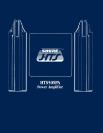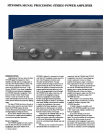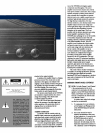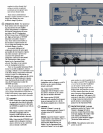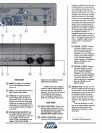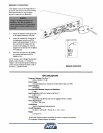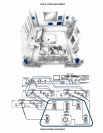
HTSSOSPA SIGNAL PROCESSING STEREO POWER AMPLIFIER
INTRODUCTION
Congratulations! You have chosen the Shure
HTSSOSPA Signal Processing Stereo Power
Amplitier, specially made
as
an integral part of
your Shure
HTS Theater Reference System. The
other elements of the Shure
HTS Reference
system are the
HTS5300 Am-Vector
'
wc
Decoder, HTSSOCF Center Front Loudspeaker,
HTSSOLRS Front and Surround Loudspeakers,
and
HTSSOW Subwoofer Loudspeaker. These
products of
Shure's Home Theater Sound
Division re-create in your home the same
realism and
immediacy
you hear in the very best
motion picture theaters and production dubbing
stages.
The Shure
HTS5300 Am-Vector Decoder is
the
main
control center for your Home Theater
System; the
HTS5300 employs the latest
exclusive Shure-patented techniques in
analog
and digital signal processing electronics.
See the System Manual included with your
HTS Decoder for complete system installation,
connection and operation information.
Theory
of Operation
The HTSSOSPA amplifier precisely matches
both the Shure HTS Decoder and Shure
HTS
Loudspeakers. The output response of the
'U.S.
Patent
4,696,036
HTSSOSPA
is
tailored to correspond to the parti-
cular Shure
HTS loudspeaker system selected in
each of its
HTSspeaker-correlated switch-
selectable Operational Modes. Through
extensive laboratory testing and many
hours of
program listening the Shure
HTS Division has
achieved
an
optimum correlation between the
program material and sound delivered to the
room.
As
the program signal
is
traced through
the HTSSOSPA to the output connectors, it
is
corrected for the loudspeakernossover
interaction, loudspeaker-to-room transfer
function and program-material dependence
whether the
prwm
is
cinema or conventional
music audio. Multiple circuit functions
combine
to control the pr-ration of an accurate
soundfield at the listener positions in a room.
Such attention to detail
is
present in only the
Enest audio systems, and the Shure HTS Theater
Reference System sets the new standard.
Consequently, the HTSSOSPA offers the user
an amplifier that
is
outstanding for highest
quality home theater audio-video presentations
as
well
as
one that provides unique signal
control in conventional multi-channel audio only
listening.
The
LRSx
and CFx extended low-frequency
Operational Modes are intended for use
respectively with the
HTSSOLRS and HTSSOCF
Loudspeakers when the
HTS system
does
not
include a subwoofer.
In
these two Modes,
amplifier low-frequency output
is
extended to
help compensate for the lack of a subwoofer.
The LRS and CF modes are
also
intended for
use with the
HTSSOLRS and HTSSOCF loud-
speakers, but in a system that
does
include the
HTSSOW Subwoofer. In these two Modes,
amplifier low frequency output cuts off at 80
Hz
to complement the frequency range of the
HTSSOW Subwoofer.
When Channel
1
is in Operational Mode
SW,
amplifier output extends from 33 to
80
Hz
to match the frequency response of the
HTSSOW Subwoofer.
To further enhance its versatility, each
channel of the
HTSSOSPA amplifier
also
includes
a "Flat" output mode,
makmg
it suitable for
use
with any loudspeaker.
An
excursion luniting circuit in the
HTSSOSPA continuously monitors the audio
signal.
This
circuitry modifies the low-frequency
response only
when
necessary to prevent
overexcursion of the loudspeaker connected to
that channel. The characteristics of
this
circuiy
depend on the Operational Mode selected since
each Mode is correlated to the
HTS Loudspeaker



